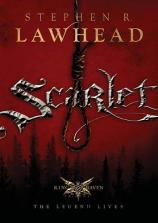Scarlet: The King Raven Trilogy, Book Two
Review
Scarlet: The King Raven Trilogy, Book Two
Historical fiction master Stephen R. Lawhead continues his legendary saga of Robin Hood in SCARLET, the second installment in the King Raven Trilogy. It’s an unusual look at a familiar story and a fascinating glimpse into a period of Great Britain’s history.
Lawhead sets his tale during the political upheaval of the 11th century, but in a departure from tradition, he moves Robin Hood from England to Wales. After William the Conqueror dies, his son, King William the Red, is coming to power and has turned his back on justice for the Welsh people. Much of the control of the land is given to ruthless and greedy barons to manage, as Lawhead portrays. As he writes in his afterword, “One of the most hated (new laws) was known as Forest Law --- a set of highly questionable legal codes designed solely for the benefit of the crown-wearer and his cronies….” This law and others cause traditional upstanding members of society to become outlaws and refugees, which forms the basis of the story.
In the first installment, HOOD, we met Rhi Bran, a rather lackadaisical young prince whose Welsh lands are appropriated and who is forced under the new laws to flee with his people to the ancient forests. There, as “King Raven,” he is tutored by an old Celtic wisewoman as he begins a quest for justice for himself and his people. Using simple techniques, Bran manages to create the illusion of a phantom that terrorizes the forests and strikes fear into the hearts of those in power.
In SCARLET, Lawhead switches his protagonist and point of view to forester Will Scarlet, made homeless by the new laws and who languishes in prison for a crime he didn’t commit. Longing for revenge, he has become part of Rhi Bran’s rag-tag band. Scarlet’s release could be easily gained if he would reveal the whereabouts of his leader, but of course he’s not telling. As the book opens, Scarlet is waiting to hang, and Lawhead uses the device of having Scarlet dictate his life story to a fascinated monk as a way to pick up the threads of the story. The opening lines capture the flavor of the prose:
“So, now. One day soon they hang me for a rogue. Fair enough. I have earned it a hundred times over, I reckon, and that’s leaving a lot of acreage unexplored. The jest of it is, the crime for which I swing is the one offence I never did do….”
As you’d expect, Lawhead has done his historical homework. The reader will be immersed in the time period with all the attendant attention to housing, clothing, food and transportation methods of the 11th century. The church is portrayed evenhandedly by Lawhead as a tool of the government, full of greedy and evil men, as well as giving us characters who are godly and charitable (watch for the third installment in 2009, TUCK, which features a monk).
The language can seem odd at times (the use of the word “fellers” to denote other men will raise an eyebrow at first), but the reader soon falls under the spell of the narrator’s skillful prose. Lawhead includes some interesting romantic elements, including Bran and Marian’s feisty relationship, Will and Nóin’s sweet courtship, and the Baron Neufmarché and his wan wife Agnes’s strange marriage.
If Lawhead continues his doorstopper-sized installments, then the King Raven Trilogy promises to total about 1,500 pages. That’s plenty of reading pleasure for historical fiction aficionados. The series will likely prompt follow-up reading about this period of change, violence and power in Great Britain’s history.
Reviewed by Cindy Crosby on June 10, 2008
Scarlet: The King Raven Trilogy, Book Two
- Publication Date: June 10, 2008
- Genres: Christian, Historical Fiction
- Paperback: 464 pages
- Publisher: Thomas Nelson
- ISBN-10: 159554089X
- ISBN-13: 9781595540898




